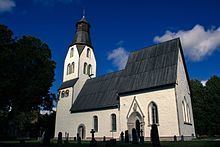 | ||
Similar | ||
Gotland island lye church
Lye Church (Swedish: Lye kyrka) is a medieval Lutheran church on the Swedish island of Gotland, in the Diocese of Visby. The church is known for having the largest set of intact medieval stained glass windows in the Nordic countries.
Contents
Lye church bells 2009
History
The oldest part of the church in Lye is the Romanesque nave, dating from the end of the 12th century or the early 13th. A decorated stone sarcophagus, which may originally have been intended as a grave or a reliquary is immured in the wall of the church. It dates from the 12th century and was carved by the stone sculptor known as Master Sigraf.
The tower of the church was added during the first half of the 1220s, and more than a century later in the 1330s, the Gothic choir was built, replacing an earlier, Romanesque choir. From its construction, it is apparent that the rebuilding of the choir was intended as a first step in a larger rebuilding scheme, but for one reason or another construction was halted after the choir was built.
There have been no major alterations to the church since - in fact, the walls connecting the Gothic choir and the Romanesque nave are still much thinner than those of the rest of the church, indicating that they were intended only as a temporary arrangement and the church has essentially been left unfinished since the 1330s. The present roof of the tower dates from 1779. The church underwent a restoration in 1954-55.
Architecture
The un-proportional church derives its external look from the fact that the rebuilding of the church during the Middle Ages was never finished. Hence the choir tends to dominate the church. The church has three external portals, two Romanesque in the nave and a larger, Gothic portal leading to the choir. The choir portal was executed by the workshop of a local stonemason sometimes referred to as Master Egypticus and contain sculptures depicting the childhood of Christ, and is crowned by a sculpture of Christ in Majesty. The tower of the church is decorated with galleries with windows.
Inside, the church is decorated with frescos from the 15th century, depicting the Passion of Christ, and from the 14th century, depicting Christ in Majesty surrounded by griffins and other imaginary animals.
The church is however probably most famous for its medieval stained glass windows. The windows, on the eastern and southern wall of the choir, date from the second quarter of the 14th century and were added to the choir when it was built. The paintings in the eastern window depict the childhood and passion of Christ, and the southern windows depict different saints, among them Catherine of Alexandria and Saint Olaf. The stained glass windows of Lye Church constitute the best-preserved set of medieval glass paintings in the Nordic countries.
Among the furnishings, the altarpiece executed in 1496 with a depiction of the Veil of Veronica on the predella deserves to be mentioned. The large triumphal cross dates from about the same time, while the baptismal font is an undecorated piece from the 13th century. In the church floor there are also several medieval gravestones, including one made for a local man called Jakob, who according to the inscription was killed by a cannonball while participating in the besieging of Eric of Pomerania at Visborg castle in the outskirts of Visby in 1449.
